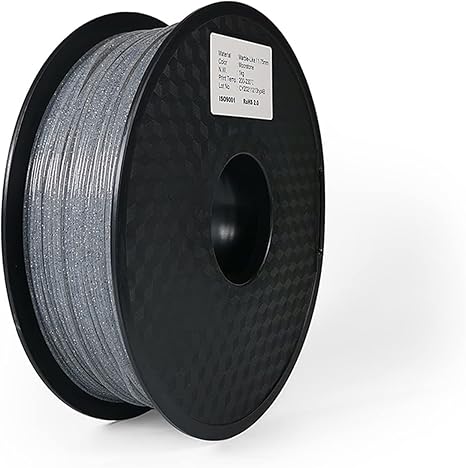Page Contents
Details: PARACAMISETAS Marble PLA Filament 1.75mm, Neatly Wound 3D Printer Filament Roll 2.2lbs Spool, White/Gray Marble Stone Color 3D Printing Material for FDM Printer, 0.02mm Fillament Vacuum Packaging,
Brand: PARACAMISETAS
Advantages
- Products can be returned
- Premium Quality PLA Filament – The 3D Printing PLA filament was neat on the roll and leaves the spool easily without any crossed turns. It produces the cleanest, least stringing prints of any of the filaments you have used whilst resisting warping and also providing the glossiest finish. Without a single jam and adhesion issue which meeting your demands for printing freely.
- Clog-free & Bubble-Free – Completely dried for 24 hours before packaging and vacuum sealed with desiccants in nylon re-bag, enable much smoother and more stable printing. perfect 3D Printer PLA Filament 1.75mm for smooth and stable 3D printing experience.
- Easy to Use: The filament 3d printing materials ensures that these filaments with a diameter of 1.75mm have a dimensional accuracy of +/- 0.03mm, 1 kg (2.2 lbs) per spool. The recommended printing temperature range is 185℃ to 230℃ (365℉‑464℉); Please remember to put it in time and keep it dry.
- Wide Compatibility – Made from starch raw materials derived from renewable plant resources, PLA filament boasts lower melting temperature, even does not need a heated bed. Anycubic PLA Filament Compatible perfectly with most FDM 3D Printers and 3D Pens that use 1.75MM filament on the market.
- High-performance: Non-toxic and tasteless when printing, and it is not dangerous to people and the environment.
Notice
- Is an online purchase
- Delivery may be delayed in some areas.
Buyer Guide 3D Printing Supplies
Before purchasing your 3D printer, it’s important to know what to look for.- Consider your intended use. Will you be using a 3D printer for prototyping, making jigs, or making toys?
- Consider your skill level. The printer you buy should be easy enough to operate.
- Consider your printing requirements. Are you working with a CAD file that needs support or has overhangs?
- Consider the material. Will your printer be able to print in ABS, PLA, nylon, or glass-filled nylon?
- Consider the build volume. Will your printer be able to print in larger parts or in thinner layers?
- Check the warranty.
How to choose 3D Printing Supplies
When shopping for 3D Printing supplies, there are several factors that you should keep in mind:Is the 3D printer compatible with your
computer? Some 3D printers require special software, while others require
their own proprietary software. Some printers work with only Mac computers,
while others work with only Windows computers.
What materials will you use?
3D printers work with hundreds of materials, including polymers, metals,
porcelain, glass, and ceramics.
What are your needs?
Some 3D printers are better than others for specific types of uses. You
may want to look for a 3D printer that will handle small objects, large
objects, or both.
How much will you spend?
3D printers can cost thousands of dollars or a few hundred.
How large is the 3D printer?
3D printers come in all shapes and sizes. Some smaller printers work well
as desktop models, whereas bigger 3D printers can be used for large
spaces.
How large will your print be?
Some 3D printers can handle large prints, while some can only handle
small print jobs.
How fast will your 3D printer print?
3D printers are rated by how fast they print, and the speed will vary
depending on your needs. Some 3D printers print at a rate of several
inches per second, while others print at a rate of inches per hour.
Will you be printing outdoors or indoors?
Some 3D printers work best indoors, while others are best used outdoors.
How to maintain 3D Printing Supplies
3D printing is a new technology that is changing the way people create and engineer new products.- To clean the filament, use soap and water to wet your filament, then wipe it dry with a paper towel.
- To clean the nozzles, wipe them with a damp rag.
- To clean the build plate, wipe it with a clean, lint-free cloth.
- To clean the extruder, use compressed air.
- To clean the build plate, first, remove any building material or part from the plate. Then, use a paper towel or paper towel moistened with rubbing alcohol to wipe off the build plate.
- To clean the extruder, first, unplug the extruder from the 3D printer. Then, moisten a paper towel or paper towel with rubbing alcohol and wipe down the extruder.
- To clean the 3D printer, use compressed air to blow loose dust out of the printer.
- To clean the filament, use compressed air to blow loose dust out of the filament.
- To clean the nozzle, use compressed air to blow loose dust out of the nozzle.
- To clean the build plate, use compressed air to blow loose dust out of the build plate.
- To clean the extruder, use compressed air to blow loose dust out of the extruder.
- To clean the filament, unplug the extruder from the 3D printer and use compressed air to blow loose dust out of the filament.
- To clean the nozzle, unplug the nozzle from the 3D printer and use compressed air to blow loose dust out of the nozzle.


